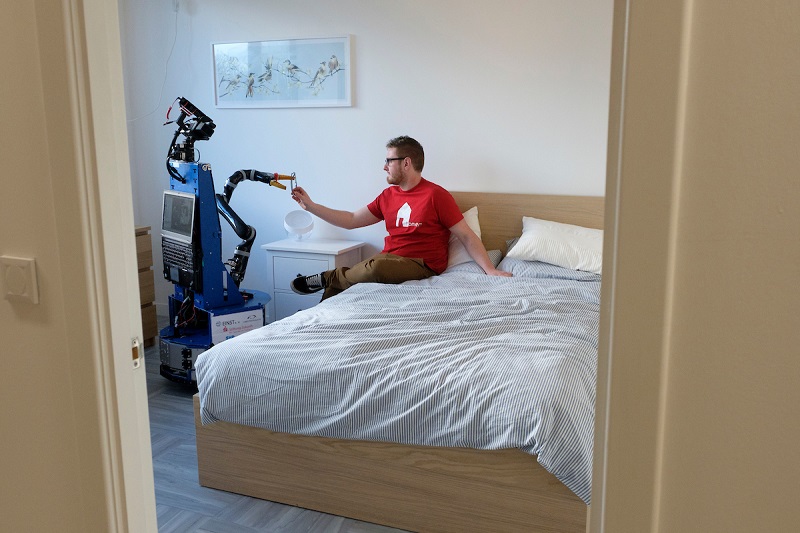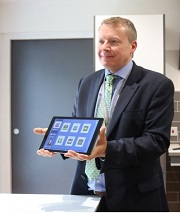Colin Foskett (pictured below), head of innovation at Blackwood Homes & Care, has collaborated with experts in robotics and sensing technology at the National Robotarium and believes lessons learned are transferable to the development of the built environment and technology adoption within healthcare settings
As a provider of affordable and accessible housing for people with an independent living need, the role of the innovation team is to co-design and co-create technology and services that aid independent living.
Collaboration is central to this work, and our partnership with the National Robotarium brings significant advantages to us – as the industry partner – as well as to the people who use our services and the academics with whom we work closely.
The National Robotarium is a world-leading centre for robotics and artificial intelligence which helps develop solutions for business and society through collaboration with industry partners in various sectors.
De-risking investment
First and foremost, collaborating with the National Robotarium allows us to draw on the expertise of leading academics to de-risk our investment in robotics innovation projects.
Through the joint exploration and development of new solutions to meet the needs of our patients, we have been able to integrate key features and maximise the benefits of the investment we have made into technology and connectivity.
Through the joint exploration and development of new solutions to meet the needs of our patients, we have been able to integrate key features and maximise the benefits of the investment we have made into technology and connectivity
An example of this is our CleverCogs system – a digital system that connects carers with patients to provide a 24/7 support service, removing the need for a sleepover by the carer.
The system is delivered through a tablet device with two-way video communication, enabling responders to triage an urgent situation and send a tailored response.
But, naturally, the camera is not necessarily where we would want it to be in the event of an incident, rendering the technology potentially unhelpful at the very moment it is needed most.
By working with the National Robotarium we are exploring ways of bringing the telepresence response to the individual through the use of robotics, extending the scope and benefit of the system, and the underlying investment, immensely.
There is additionally a multiplier effect on investment: when we deploy a new technology we can look at retrofitting it as a feature in existing patients’ homes, too, maximising the benefits of the investment.
The know-how to integrate robotics, sensing technology, and the Internet of Things into existing facilities is pivotal to maximising reach and extending the independence of living enjoyed by our patients, and is something our academic partners are well placed to advise us on.
Delivering tangible outputs
The second key advantage of collaborating with an engaged group of leading researchers is that it accelerates the process of moving assistive technologies from lab to market, and the delivery of real, practical outputs to solve the varied and complex issues faced by our residents.
Through trialling new technologies in the National Robotarium’s assisted living labs, researchers and designers have the opportunity to work directly with end users during the research phase so that the technology is developed specifically with their needs and requirements in mind, and with input that shapes the final outcome.
The know-how to integrate robotics, sensing technology, and the Internet of Things into existing facilities is pivotal to maximising reach and extending the independence of living enjoyed by our patients
In order to demonstrate to patients the features we can use to customise their homes, a project is underway to offer a virtual tour of our show home.
This need became particularly evident during the pandemic and is being made possible through the deployment of virtual presence robots which allow people to move through our showhome from the comfort of their current home, and interact with the features and with someone physically in the house.
While the idea for this service was borne out of lockdown, it has applicability for the long term, particularly benefiting those customers with accessibility needs.
Another collaborative project – EMERGENCE – includes NHS trusts, another housing association, and robotics manufacturers, alongside numerous universities.
Its purpose is to establish a collaborative network covering the full spectrum of lab to market and incorporating patients and healthcare providers to examine practical applications of robotics in health and social care for the future.
A key principle for us is to involve our end users where possible in the design of their facilities, and this project allows us to take that ethos of co-design and co-creation one step further and facilitates interaction between those end users and the robots themselves.
Further practical outputs of our collaborative work with the National Robotarium include bringing telepresence robotics into our night support service and utilising sensing technology to pinpoint a resident’s location within a building to ensure their safety and wellbeing.
These examples, in particular further, demonstrate how the benefits and learnings of this work can translate more widely to health and social care services, facilities and devices.

The collaboration is helping to accelerate the process of moving innovative assistive technologies from lab to market
Achievements and ambitions
The collaboration has confirmed early hopes that robotics is something our patients would like to interact with in the future.
It is clear that this is an area worthy of further exploration and investment, and the collaboration has consolidated Blackwood’s intention to include robotics in strategic planning going forward.
Academic collaboration opens up opportunities for students to engage with industry.
Collaborating with an engaged group of leading researchers accelerates the process of moving assistive technologies from lab to market, and the delivery of real, practical outputs to solve the varied and complex issues faced by our residents
For example, one of the Blackwood Design Awards, which aim to stimulate innovation in independent living, was won by a robotics student at Heriot-Watt University.
Furthermore, recently we have been granted funding for a Knowledge Transfer Partnership (KTP) with the National Robotarium and look forward to the opportunity to work alongside a research associate with the aim of exploring further potential applications of robotics in the housing and care sector.

The extent of the growth and added value that my team has gained from working alongside academia has exceeded expectations.
The co-design workshops that we took part in with the National Robotarium as part of the OpenAAL project hugely raised our own understanding of sensing technologies, the Internet of Things, and how robots interact with their surroundings.
This project – the Open Ambient Assisted Living Project led by the Care Group at Heriot-Watt University – targeted rapid co-creation of scalable and affordable solutions for the care of vulnerable people.
We are excited to examine whether the telepresence and robotic support offered by CleverCogs might be extended to provide those patients with more-severe disabilities or restrictions on movement to visit places virtually.
Modifications to the technology that we have already invested in, to extend the benefits to patients in different situations, is a key advantage stemming from the collaboration.
Widening opportunities for the future
At a time when financial budgets for health and social care are under severe pressure, working closely with researchers in the field of robotics and technology opens up opportunities to explore whether there are other, new ways we can use technology to complement existing care packages, support carers to do their jobs as well as possible, and deliver services that enhance the quality of life of all patients.
A partnership like ours is supportive in translating theory into practical results that will improve quality of life and promote independent living
All this is in addition to easing the financial pressure and maximising the reach of investments in innovation.
Collaboration with experts like the National Robotarium not only ensures that investments in technology are de-risked as much as possible and maximised in terms of reach and opportunity, but also, a partnership like ours is supportive in translating theory into practical results that will improve quality of life and promote independent living.
